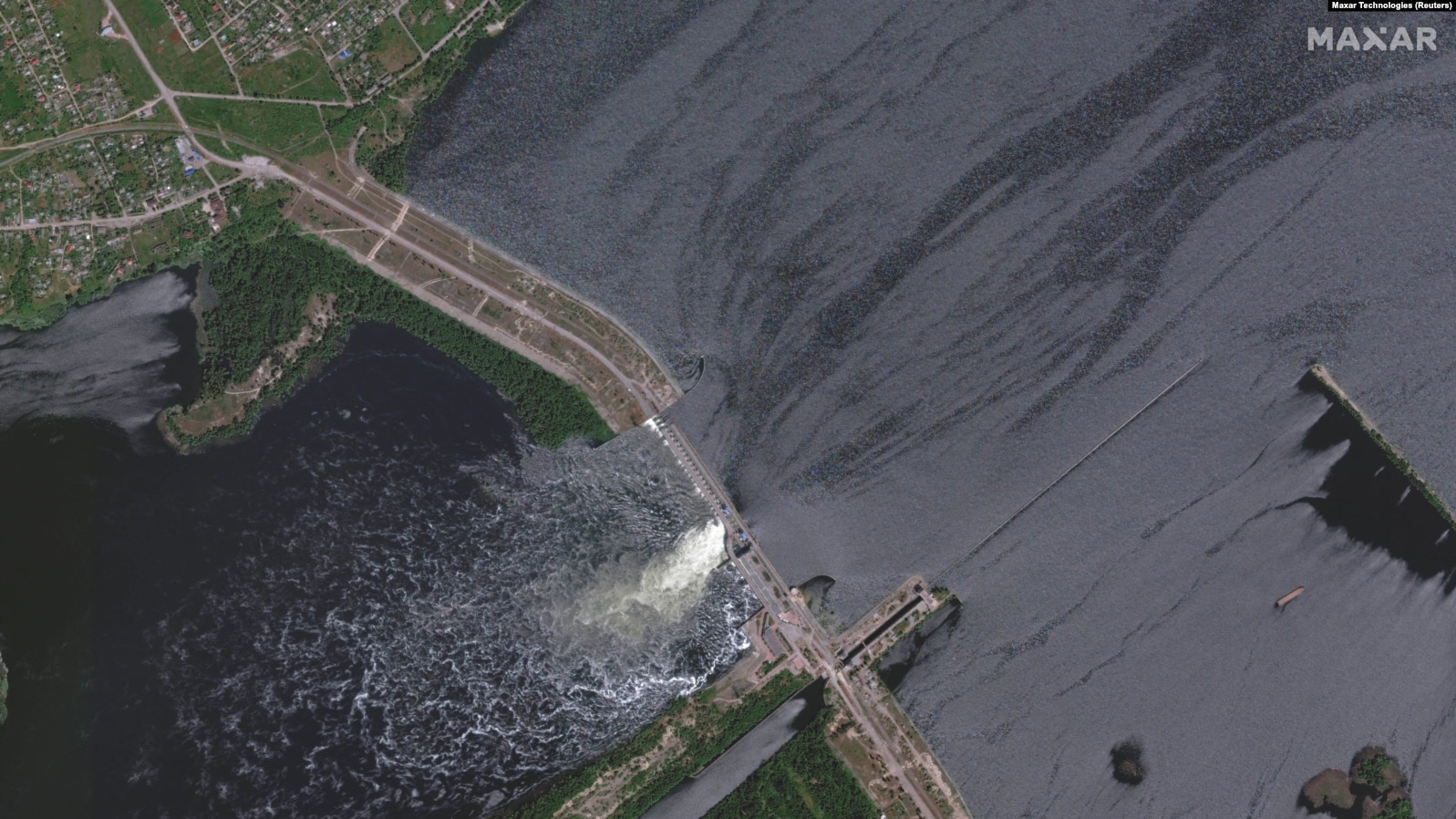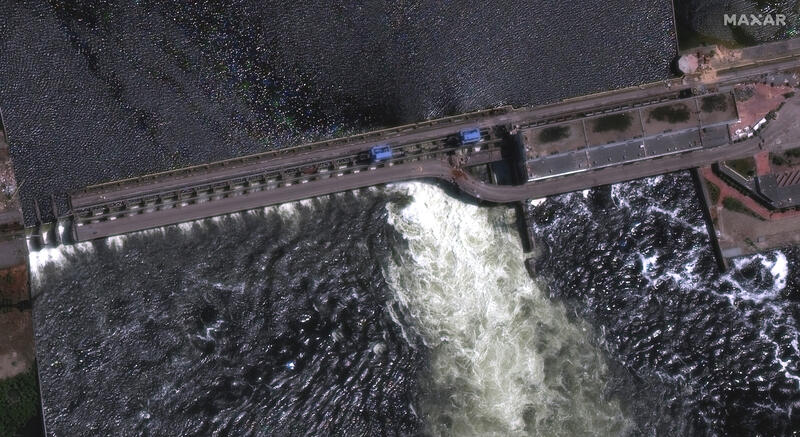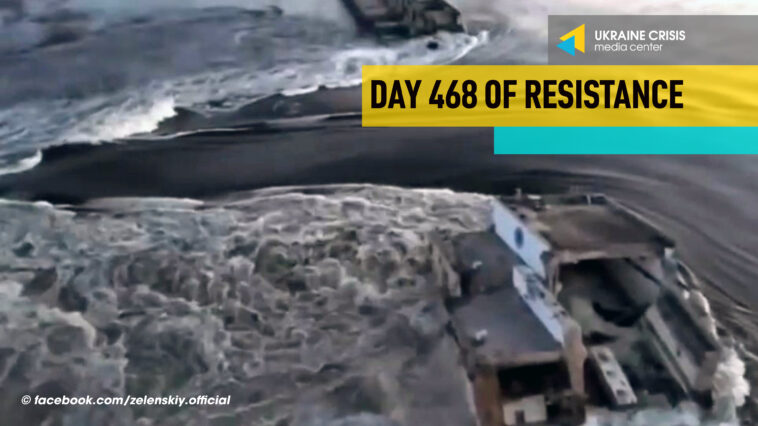At 2:50 a.m. on June 6, Russian forces blew up the dam of the Kakhovka hydroelectric power plant that supplies electricity and drinking water to southern Ukraine.
The reservoir also provides cooling water to the Zaporizhzhia nuclear power plant. Water levels on the Dnipro river affect the plant’s cooling ponds.

In the first hours after the explosion, water completely or partially flooded eight towns and villages on the right bank and a neighborhood in the city of Kherson. Around 16,000 people on the right bank of Kherson region are in a critical zone. The left bank, occupied by Russia, is at a higher risk of severe flooding as it sits lower in elevation.
About 80 towns and villages downstream along the Dnipro, including part of the city of Kherson, are in the possible flood zone. The Kherson regional military administration ordered evacuations from Mykolayivka, Olhivka, Lvove, Tyahynka, Ponyativka, Ivanivka, Tokarivka, Prydniprovske, Sadove, and the Korabel (Ostriv) district in Kherson. Ukrainian authorities called on the residents of the Russia-held areas on the left bank in Kherson region to take care of their safety.
Russian forces blew up the station from inside, and the plant cannot be restored, Ukrhydroenergo said. A large part of the dam was destroyed.

In Kryvyi Rih, in Dnipropetrovska region, water supply to customers was restricted due to water shortages.
Ukraine’s defense intelligence and Ukrhydroenergo warned of additional risks for the Russia-occupied Zaporizhzhia nuclear power plant. Turbine condensers and safety systems at the plant use water from the Kakhovka reservoir.
The collapse of the Kakhovka dam may also result in flooding of the Kherson thermal power plant. In Kherson, about 12,000 consumers have been cut off from electricity. It may cause water supply interruption.
In Crimea’s Kerch, Yevpatoriya, and Dzhaknoy, the quality of water has dropped dramatically. A water supply schedule was introduced.
President Zelenskyi convenes National Security and Defense Council
On the morning of June 6, President Zelenskyi convened an emergency meeting of the National Security and Defense Council.
One of the participants told the news site Ukrainska Pravda that the meeting was “dynamic”. “Everyone reported quickly and clearly, avoiding getting too emotional: we heard situation reports, most likely prospects, and plans. A quick discussion, and everyone rushed to begin work,” the unnamed official said.
Russian forces blew up the dam with explosives that they planted last autumn, when President Zelenskyi warned of such a scenario in his address to the European Council.
“At the meeting, the military said the blast occurred at around 3 a.m. They denied their involvement, saying that our troops did not launch an attack. It was the Russians who blew up the station,” the official said. “Everyone got a task, like making a submission to the International Criminal Court, requesting a UN Security Council meeting etc.,” he added.
Ukraine’s Foreign Affairs Minister Dmytro Kuleba was made responsible for calling an emergency meeting of the UN Security Council, the source said.
According to one of the reports heard, Kherson will be inundated after one day, but in four to six days the levels will fall to normal.
What’s going on in occupied part of Kherson region?
In the early hours of Tuesday, the Russian-imposed authorities claimed “the dam was not destroyed”, and reassured the residents the situation was “under control”.
After the dam blast, the Russians gave no instructions to people in Nova Kakhovka, the city’s mayor in exile Oleksandr Kovalenko told Ukrainska Pravda.
A resident of Nova Kakhovka who left the city a few months ago, said that in the flooded areas of the city “there are no representatives of the Federal Security Service (FSB), just infantry soldiers who do not know what to do.”
Later, the Russian-installed authorities in Nova Kakhovka ordered partial evacuations.
People in Nova Kakhovka, Hola Prystan, and Oleshky received text messages from the Russian Emergency Service, calling to prepare their belongings, documents, food, and water for three days.
Consequences for Crimea
The collapse of the Kakhovka hydroelectric power plant will affect the supply of water to occupied Crimea. Russian forces began restoring the water supply through the North Crimea Canal in the days immediately following Russia’s invasion of Kherson region. The canal will again remain without water.
“The canal was part of a system that includes the Kakhovka hydropower plants. If the levels dramatically fall – and they are falling – the water will not get into the canal. It can only be pumped, but that is unlikely to happen,” Serhiy Hapon, analyst at the World Data Center said.
The canal may dry up in the coming days, he added.
Following months with a lot of precipitation, water reservoirs in Crimea are now full. Drying up of the canal will not be felt as an immediate problem, he said.
Collapse of dam to affect Ukraine’s counteroffensive in south?
The front line in Kherson region has not moved since November 2022. Still, the south is considered to be among the key directions of the Ukrainian counteroffensive.
To retake the south, the Ukrainian Armed Forces will have to cross the Dnipro either by water outside Kherson, or by land in Zaporizhzhia region.
If Ukraine chooses to advance from Kherson, the flood will increase the distance to the Russian positions and will complicate the use of heavy equipment.
There are no signs that Ukrainian troops ready to cross the Dnipro, and the collapse of the dam will not affect the counteroffensive, Roman Kostenko, an MP and service member, said.
“It is highly unlikely that Ukrainian troops will try to cross the Dnipro in the south. It would have caused heavy casualties. The troops would also have to hold a foothold. (…) The enemy blew up the dam that was the only facility that connected the banks of the river,” Kostenko said.
Blowing up of dam is a crime
Laws of war established in the Geneva Conventions prohibit attacks on dams. The blowing up of the hydroelectric power plant is a crime.
Its use by the military is not an exception. A collapse will cause grave consequences for civilians.
An attack on a dam would only be acceptable if it was used as a military object, which is not the case here.
Russian terrorist attack causes humanitarian disaster of international scale. Ukraine in Flames #453
At 2:50 a.m., on June 6, a disaster occurred that Ukrainians were warning the world about and when talking about its consequences sometimes resorted to apocalyptic scenarios. russian troops blew up the Kakhovka HPP dam, a station that supplies southern Ukraine with electricity and fresh water. This station is also important for the operation of the Zaporizhzhia NPP, as the capacity of its cooling ponds depends on the water level in the Dnipro. In the first hours after the detonation, the water completely or partially flooded eight settlements and one micro-district of Kherson on the right bank. About 16,000 people on the right bank of the Kherson region found themselves in a critical zone. The left bank, occupied by the russians, was in even greater danger – as it is lower in terrain. Watch Ukraine in flames #453 to find out about russian attack on Kakhovka dam and the consequences that will be felt even outside the borders of Ukraine.
Guests:
- Oleksandr Tolokonnikov, Spokesman of the Kherson Regional Military Administration
- Victoria Voytsitska, Member of the Parliament of Ukraine of the 8th Convocation, International Center for Ukraine’s Victory
- Volodymyr Kovalenko, Mayor of Nova Kakhovka
- Andriy Pavelko, Leading Lawyer at Сharitable Organization “Ecology – Law – Man”




